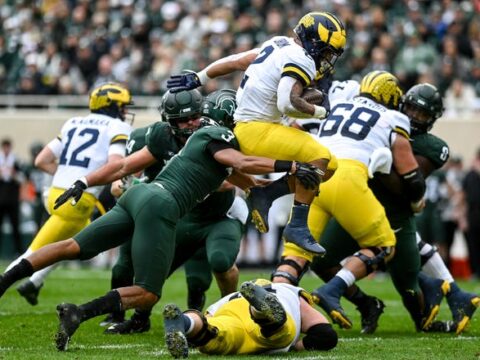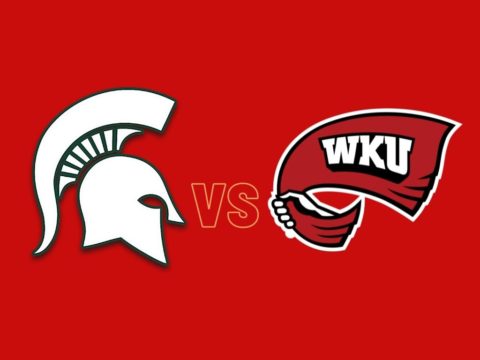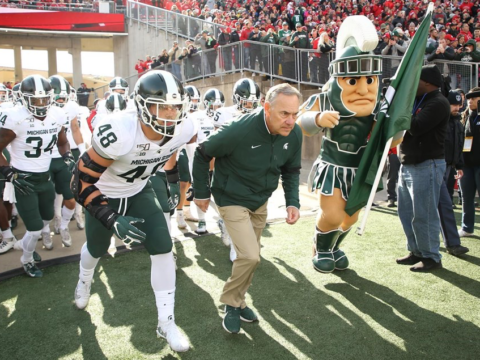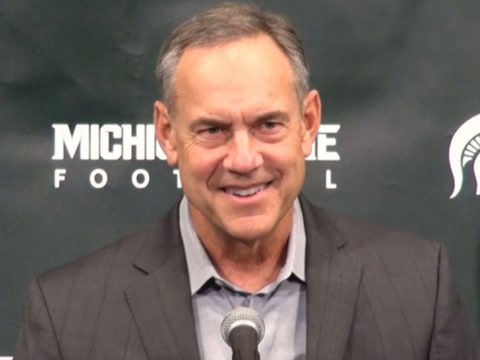
These are tough times for Michigan State Football
National signing day was Feb 3 and the results were unsatisfying.
The Spartans concluded the recruiting campaign with the #43 recruiting class in the country, or if you prefer, #10 in the Big Ten. It’s also notable the recruiting ranking fell precipitously with the loss of two (2) highly regarded 4-Star players after the Spartans concluded a losing season.
Of course, the Spartans struggled on the field.
The Spartans finished a virus shortened season with a 2-5 record, averaging just 18 points, underscored by their worst Rushing Offense since 1947.
And now, the roster is in flux.
In the past three months, Spartan Football lost an unprecedented 16 players via the Transfer Portal and only added 10 players via the same process. That’s a net loss of 6 players and regardless of what anyone might think of the “outbound” players, it is still a loss of 16 football players who spent a year or more on campus.
So, given the results of the past year, I intend to review what I perceive to be flaws in football operations, recruiting woes and the Transfer Portal, and ask the question “can Mel Tucker, with the help of President Stanley and AD Beekman, measure up to the high standards set by Hannah, Munn and Daugherty?”.
And at the conclusion of this missive, I would like to explain a bit of my editorial philosophy, because there are a few who think I have been unfairly critical of Mel Tucker.
So, I would like to explain a bit of my Editorial philosophy and set the record straight because it is not my intention to be arbitrarily critical of Mel Tucker or anyone else associated with Spartan Football. Rather my philosophy is to simply follow the facts and let the facts speak for themselves.
This missive is longer than normal, so I hope you will read along to the end, especially those who think I have been unfairly critical of Mel Tucker.
Who has the Will2Win?
The name of my blog is “Will2Win” and it was chosen for a specific reason.
Coaches at virtually every Power 5 school talk about winning championships, but do they really have the Will2Win? Are they willing to “go the hard yards”, make the tough decisions and make the inconvenient sacrifices that it takes to win at the highest level?
A lot of schools talk about it, but few live it, and even fewer achieve it.
Alabama does. Ohio State does, but even schools with less celebrity such as Wisconsin and Iowa do, yet the schools that consistently rise to the top represent a small percentage of 130 D-1/FBS schools.
Wisconsin is an interesting case study. Wisconsin was a broken program before Donna Shalala (Chancellor) and AD, Pat Richter handpicked Barry Alvarez in 1990 to rebuild football operations, yet since that time Wisconsin has become a model of consistency.
From 1990 to 2005, Alvarez has won 3 Big Ten titles, 3 Rose Bowls, and finished in the Top 25 six times including three Top 10 finishes.
Thereafter, Alvarez was promoted to AD, and from 2006 to 2021, Alvarez has hired 3 different coaches (Bret Bielema, Gary Andersen, and Paul Chryst), each of whom compiled winning records, and each led Wisconsin to the Big Ten Championship Game. In fact, Wisconsin has appeared in 6 Big Ten Championship Games (tied with Ohio State for the most) and along the way, finished in the Top 25 in eleven separate seasons from 2006 to 2021, only missing the Top 25 four times. Wisconsin has become a model of consistency.
Iowa was also a broken program, winning just 8 games from 1974 to 1978, before Iowa AD, Chalmers “Bump” Elliott, handpicked Hayden Fry from North Texas State to rebuild Iowa Football. Yet from 1979 to 1998, Hayden Fry won 3 Big Ten titles, appeared in 14 Bowl games, and posted double digit wins in 3 seasons.
Kirk Ferentz was on Hayden Fry’s staff and took the reins at Iowa in 1999 after Fry stepped down. Since 1999, Ferentz won 2 Big Ten titles, 1 Big Ten West title, appeared in 18 Bowl games (only missing 4 seasons) finished in the Top 25 in nine separate seasons including five (5) Top 10 finishes.
Yet Alvarez, Frye and Ferentz didn’t achieve success in a vacuum. They benefitted from the enormous support of their respective Presidents & AD’s, after all, there must be commitment at the highest level, to win at the highest level, and clearly, the sustained success of Wisconsin and Iowa over the past 30-40 years, represents commitment at the highest level, but what about Michigan State?
John Hannah had a vision and built a formidable football power:
As most of my readers know, John Hannah was President of Michigan State from 1941 until 1969 and he put an indelible stamp of excellence on Spartan Football during the 50’s & 60’s.
Prior to John Hannah, Michigan State achieved a measure of football success, but mostly on a regional basis, and certainly not competing for National Titles.
Yet Hannah had a plan.
Hannah had the audacity to think he could transform a smallish agricultural college into a consistent and formidable football power. He had a plan to make Spartan Football his calling card when he met with legislators and donors as he commenced his plan to raise money and grow Michigan State College into one of the 10 largest research universities in the world.
But to build a championship football program, Hannah needed a Championship caliber coach and he handpicked “Biggie” Munn and gave him the mission to build a champion. Munn was up to the task.
Munn assembled an incredible cadre of Assistant Coaches, including Bob Devaney, Dan Devine, Forest Evashevski, and of course Duffy Daugherty each of whom ultimately went on to become Head Coaches in their own regard, and all but Evashevski won National Titles.
Of course, Duffy Daugherty established his mark and won or shared 4 National Titles at Michigan State; Bob Devaney went on to win eight (8) Big 8 Conference Championships at Nebraska, including “back-to-back” National Titles in ’70 & ’71; and from 1955 to 1970, Dan Devine compiled a distinguished career as Head Coach at Arizona State, and Missouri, but then went on to win a National Title at Notre Dame in 1977.
Although Evashevski never won a National Title at Iowa, nevertheless he had an incredible career finishing in the Top 5 four times between 1956 and 1960.
So, Munn assembled a gifted cadre of assistant coaches and it paid dividends immediately.
From 1947 to 1949, Munn compiled a record of 19-7-2 (68%) and Michigan State finished in the Top 25 twice for the first time in history.
But it was his tenure from 1950 to 1953 that identified Munn as a brilliant coach, strategist and tactician.
From 1950 to 1953 Munn compiled an incredible record of 35-2 (95%), including two unbeaten seasons, two back-to-back National Championships (’51 & ’52), a Big Ten title (’53), and a Rose Bowl (1954).
Biggie Munn never had a losing season.
Thereafter, Hannah promoted Munn to AD and gave Munn marching orders to put non-revenue sports on the national map, and Munn did exactly that: Gymnastics, Swimming, Track & Field and Wrestling arose to national prominence.
Even though Munn assumed the role of AD, his fingerprints continued to be all over Spartan football. Munn promoted Duffy Daugherty to Head Football Coach and behind the scenes, Munn helped fine tune football operations, expanded football facilities, and set the stage for more national success.
In his new role as Head Football Coach, Duffy immediately added his own set of assistant coaches, including but not limited to former Spartan player Sonny Grandelius and Bill Yeoman, once again establishing the importance of building a cadre of championship caliber assistant coaches. Grandelius went on to coach University of Colorado where he won a Big Eight conference title in 1961 including a Top 10 finish.
Yeoman went on to become Head Football Coach at University of Houston whereby he created the “Houston Veer”, the most potent offense in the country in the late 60’s which showcased Warren McVea at Running Back. Of course, that brought national recognition to both Yeoman and University of Houston and along the way, Yeoman won 4 Southwest Conference titles complemented by four (4) Top 10 finishes.
Duffy’s staff evolved considerably over 18 years, and while I won’t recite all their names here, one of his most notable assistants was former Spartan player, Hank Bullough. Bullough went on to coach Buffalo in the NFL, but at Michigan State he distinguished himself as “Dr. Defense”, developing two of the most dominant collegiate Defenses of all time in 1965 and 1966.
Every Spartan player who ever played for Hank Bullough will tell you, they were determined to never lose a Defensive battle in the trenches because they feared the wrath of Hank Bullough on the sidelines.
So, with Duffy at the helm and with a cadre of championship caliber assistant coaches on staff, Michigan State went on to win (or share) 4 more National Titles (’55, ’57, ’65 & ’66) and that concluded an unprecedented run whereby Spartan Football, from 1951 to 1966, won or shared 6 National Titles in just 15 years.
Overall, from 1947 to 1966, Spartan Football finished in the Top 25 in 14 separate seasons, including 11 Top 10 finishes, and you can thank the organizational brain trust of John Hannah, Biggie Munn and Duffy Daugherty for building an incredible football operation complemented by a cadre of championship caliber Assistant Coaches.
But things were about to change:
Hannah stepped down in 1969, Munn stepped down in 1971, and Duffy stepped down in 1972, and the magical run of the 50’s & 60’s was replaced by a carousel of coaches, and from 1976 to 2006, Spartan Football was mired in mediocrity compiling a dismal record of 174-177-7 (49%).
Of course, there were a few highs under Darryl Rogers, George Perles and Nick Saban, but it paled when compared to the Hannah/Munn/Daugherty era.
From 1976 to 2006 (3 decades) Spartan Football won a single Big Ten title in 1987, shared the Big Ten title just twice in 1978 & 1990, finished in the Top 10 just twice, never finishing in the Top 5, and never competing for a National Title.
It was that inconsistency from 1976 to 2006 that inspired me to create my Blog in 2007 because I wanted to explore the proposition: does Michigan State, its President and AD have the Will2Win in the 21st century?
Of course, Mark Dantonio arrived in December 2006 with the blessing of Mark Hollis and President Simon.
When he arrived, optimism was tepid. In fact, there was an abundance of skepticism considering that Mark Dantonio inherited a team that compiled an upside-down record of 38-45 (45%) with just 2 winning seasons in the previous 7 years.
Nevertheless, I was bullish on Mark Dantonio because he had championship credentials.
After all, he had built a dominating defense as Defensive Coordinator on Jim Tressel’s 2002 National Championship team at Ohio State, and as Head Coach he elevated once dormant Cincinnati into the national spotlight.
So, I thought Mark Dantonio had the wherewithal to do the same at Michigan State. When he arrived at Michigan State he brought his entire staff of assistant coaches with him, and they hit the ground running: winning 7 games in the first season and earning a bowl invitation.
Of course, MD went on to become the winningest coach in Spartan history, compiling a record of 114-57 (67%) including 3 Big Ten titles, a Rose Bowl Victory, 3 “Top 5” finishes and an invitation to the College Football Playoff.
But it was the span from 2010 to 2015 that Mark Dantonio established Spartan Football as Elite once again, winning 80% of its games, and of course MD benefitted from ample support from President Simon and Mark Hollis (AD).
It appeared Mark Dantonio had reestablished Spartan Football as a formidable and consistent football power in the likeness of the 50’s & ‘60’s.
But those expectations soon faded…
Mark Dantonio stepped down and confusion set in.
By all accounts, there was no succession plan in place, and it appeared as though the AD didn’t have a short list of candidates at the ready.
Confusion and missteps ensued. An offer was extended to Luke Fickell a highly regarded candidate, but Fickell publicly rebuffed the offer. As a second option, the Spartans offered Mel Tucker, but he rebuffed the Spartans offer as well, preferring to stay at Colorado. But after a more lucrative offer was put on the table, Mel Tucker accepted.
It was a humiliating and humbling exercise for a proud university like Michigan State.
And while the Spartans had hired a new Head Coach, the Head Coach didn’t have a readymade staff and he had to go shopping.
The start of the Mel Tucker era did not resemble the smooth efficiency with which Biggie Munn assembled his first staff of assistants, or the smooth transition of Mark Dantonio who brought his entire staff with him.
So, the stability of the Mark Dantonio era was replaced by the uncertainty of the Mel Tucker era and it was immediately evident upon the football field.
In his first season, Mel Tucker won just 2 games (29% winning percentage) underscored by some of the worst measurables in Spartan Football history:
- Offensive production including yardage, 3rd Down Conversions, and Offensive Scoring were dead last in Big Ten.
- Rushing yardage was the worst since 1947 and Running Backs failed to score a Rushing Touchdown for the first time in history.
- Offensive Scoring was the worst in 2 decades and ball security was amongst the worst in the country.
- The Defense regressed in all 3 phases: Rushing, Passing and Scoring.
- Defensive scoring was dead last in the Big Ten.
Those dismal measurables are undeniable!
So, for those who think I have been unfairly critical of Mel Tucker, then I point to the preceding measurables and ask the question: how does one write upbeat articles based upon a laundry list of bad stats?
And recruiting is just another set of problems.
Recruiting: what comes first, the Chicken or the Egg?
In addition to overseeing a losing season, Mel Tucker just concluded an unsatisfying recruiting cycle by assembling the #43 recruiting class in the country, ranking behind lower tier programs including Maryland, Pitt, Cal, BC and Rutgers.
Yet, if the Spartans hope to compete for championships on the football field, then they need to improve the quality of the players they put on the field.
But recruiting is the classic chicken and egg conundrum, and it’s fair to ask: what comes first, the chicken or the egg? Or said another way, what comes first, winning or recruiting?
After all, the best recruits want to play for winning programs, yet once a program descends from winning to losing, then recruiting becomes infinitely more complicated because coaches are forced to answer inconvenient questions, such as: “…why would I want to play for a team that is not a championship contender?”.
Today’s top recruits are savvy.
They may be high school students, but they become de facto contract attorneys during the recruiting process. Recruits compile a dossier on every school and every coaching staff.
The top recruits know which coaches are winning, which coaches are losing, which programs are trending up, and which programs are trending down and that’s why you never see a losing program with a Top 10 recruiting class.
Mel Tucker learned that the hard way in his first recruiting cycle.
The Spartans lost Audric Estine, a 4-Star, Running Back from NJ who reneged on his commitment to the Spartans in December, and chose Notre Dame after the Spartans finished 2-5.
And on February 3, the last day of the recruiting cycle, the Spartans lost Rayshaun Benny, a 4-Star, D-Lineman from Oak Park (MI) who reneged on his commitment and flipped to Michigan.
Consequently, Mel Tucker’s first recruiting class is less than championship caliber in terms of quality (ranked #43) or quantity (just 19 recruits).
It’s also worth noting only one Spartan recruiting class since 2007 ranked lower.
Here is another measurable: Mel Tucker recruited just one (1) 4 Star player and Zero 5-Stars.
That pales when compared to the best teams in the Big Ten, including Ohio State which recruited 18 (4&5, Star players); Michigan recruited 13 (4&5, Star players); Iowa recruited 7 (4&5, Star players); and Wisconsin recruited 6, (4&5, Star players). Meanwhile, the Spartans recruited just one!
And let’s not give Mel Tucker a pass simply because he is a first year Head Coach, because there are at least 9 other first year coaching staffs at Power 5 schools, all of whom had better “Recruiting” classes than the Spartans, including: Ole Miss; Florida State; Arkansas; Miss State; Missouri; Auburn; Washington; Boston College and Rutgers. Yes, Rutgers!!!
That means the Spartans will be preparing for the 2021 season with a shortage of player personnel, an unknown Depth Chart, and the Transfer Portal is just another level of recruiting uncertainty.
Transfer Portal is no panacea:
Let’s remember, the Spartans lost an unprecedented 16 players in the Transfer Portal including two (2) 4-Stars, thirteen (13) 3-Stars, and a walk on.
And regardless of opinions regarding the “outbound” players, they represent a bounty of talent that was systematically scouted and thereafter spent a year or more on campus, and yet those players all headed for the exit.
Let’s remember, each Spartan player who departed in the Transfer Portal only received their scholarship from Mark Dantonio after “camping” at Michigan State, which meant MD and his staff had a week of on campus drills to assess their athleticism and determine their “fit” on the roster.
Regardless, in spite of losing 16 players, the Spartans have only acquired 10 players via the Transfer Portal, yet 5 of those players come with an abundance of question marks and two players come with an asterisk.
Here are 5 question marks:
The “inbound” players include an unranked Safety from North Greenville College (Division II)…an unranked Cornerback from Wheaton College (Division III)…a two (2) Star Linebacker from Army…a three (3) Star Quarterback from Temple and an three (3) Star Offensive Lineman from Arkansas State, and let’s note, Arkansas State, Army and Temple are non-Power 5 schools.
And, here are two players noted with an asterisk:
*The Spartans grabbed a 4-Star RB from Auburn, but that player delayed his arrival until summer (for some unknown reason), and with respect to the unpredictability of recruiting, that player is in the high-risk category until he officially arrives on campus. If this player doesn’t arrive until mid-summer, how much of an impact will he make?
**The Spartans grabbed a 3-Star “Athlete” who was originally recruited by Michigan in 2018. He is a utility Linebacker/Fullback commencing his fourth season, yet given 3 years as a utility player at Michigan, his is not considered a game changing playmaker.
The Spartans also grabbed a 3-Star Running Back from Wake Forest: a 4-Star D-End from Duke and a 3-Star Cornerback from Florida yet their fit and future impact is entirely unknown as well.
In summary, the Spartans lost two (2) 4-Stars, 13 (13) 3-Stars and a walk on via the Transfer Portal, and in return the Spartans acquired: one (1) 4-Star; one (1) 4-Star with an asterisk; five (5) 3-Stars; a 2-Star, and two (2) unranked players.
Of course, two unranked players are coming from D-II & D-III schools respectively and it is totally uncertain if they would make the roster of any Big Ten team.
At any measure, attempting to build a roster via the Transfer Portal is not only unprecedented, moreover it’s unconventional and unorthodox.
Why do I say that?
Because the Top 10 recruiting teams in the country, including Alabama, Ohio State, LSU, Georgia, Clemson, Oregon, Texas A&M, USC, Notre Dame and Michigan have only recruited 8 players cumulatively from the Transfer Portal or less than 1 player per team.
Equally noteworthy, the Top 10 recruiting teams lost ZERO “outbound” players via the Transfer Portal compared to the Spartans losing 16.
Clearly Mel Tucker is relying upon an unproven strategy to build his roster via the Transfer Portal, but I would refer to it as a flawed strategy.
The Transfer Portal is not a viable substitute for conventional recruiting, and let’s remember the reason the Transfer Portal was implemented in the first place.
The Transfer Portal is simply a nod toward erasing the perception that recruiting is a form of indentured servitude and so the Transfer Portal exists because it bestows rights upon recruits, giving them a measure of free agency.
It enables players to explore a second chance to play at another school (acknowledging that a player may have made a mistake with his first choice).
The Transfer Portal also gives a select few teams an opportunity to add a “key” player or two to their roster, ala LSU adding QB, Joe Burrow who won a National Title; or Ohio State adding QB, Justin Fields who guided the Buckeyes to two consecutive CFP appearances.
But by and large, the Transfer Portal is not stocked with 4&5 Star playmakers and most of the players in the Transfer Portal are simply “job shopping” and looking for a home.
Will2Win Editorial Policy:
And that brings me to my Editorial Policy, and its simple: I am committed to providing the facts, stats and numbers that your friendly “Beat Writers” gloss over.
I also zealously protect my independent voice.
And to ensure my voice remains independent, I don’t accept remuneration from subscribers, sponsors or special interest groups and that enables me to stay independent and unbiased and it also ensures that my commentary remains unvarnished and uncompromised.
In brief, it enables me to call it as I see it…
The only thing I am beholden to are the facts, stats, and numbers, and of course those are created by players and coaches on the football field. I simply distill the stats, facts and numbers and try to present them in a coherent commentary.
So, when I write positive commentary, as I did for most of the Mark Dantonio era, it was because the facts guided me in that direction. Conversely, when I have written critical commentary regarding Mel Tucker and his coaching staff, it’s because the facts guided me in that direction as well.
So, my Editorial Policy is simple: follow the numbers, and one thing is certain, I refuse to be a cheerleader for losing football.
Will2Win Benchmarks:
In academics, business and sports, it’s important to have Benchmarks and a grading scale to guide judgements.
I’m uncertain what criteria Michigan State AD uses to grade Spartan Football but here is my grading scale based upon 12 regular season games:
- 6 regular season wins earns the lowest possible passing grade.
- 9 regular season wins passes with honor’s.
- 10-11 regular season wins is elite.
- 12 regular season wins is achievement with distinction…Summa Cum Laude if you will.
Of course, Mel Tucker just completed his first year by posting a 2-5 record, albeit a virus shortened season, but the winning percentage was just 29%, and by all measures, that’s a failing grade.
And that brings me to ask the question, can Spartan Football correct course? And does Michigan State President, AD and Head Football Coach have the Will2Win?
If so, what is their plan to correct course?
At the bottom line (the bar is high, but that is how Stanley, Beekman and Tucker will be measured):
Mel Tucker repeatedly talks about changing the culture at Michigan State, yet I still don’t know what that means.
Of course, if it means he intends to build a football organization with a cadre of championship caliber assistant coaches in the modern-day likeness of Hannah/Munn & Daugherty, then I think Spartan stakeholders everywhere would support that plan.
Yet, as we look at current operations, including won/lost record, coaching staff, and questionable strategies for building a roster, it would be fair to conclude Mel Tucker is not on the same path.
I’m sure Mel Tucker’s current staff are good men of good character, but we don’t see latter-day Duffy Daugherty’s, Bob Devaney’s, Dan Devine’s, Forest Evashevski’s, Bill Yeoman’s or Hank Bullough’s, and the stats suggest the coaching staff need to pick up their game.
Let’s recap again:
- Offensive yardage, 3rd Down Conversions and Offensive scoring were dead last in Big Ten.
- Rushing yardage was the worst since 1947 while Running Backs failed to score a Rushing Touchdown for the first time in history.
- Offensive Scoring was the worst in 2 decades and ball security was amongst the worst in the country.
- The Defense regressed in all 3 phases: Rushing, Passing and Scoring.
- Defensive scoring was dead last in the Big Ten.
When measured in Big Ten competition, the Spartans Offense ranked dead last in scoring, while the Spartan Defense ranked dead last in points yielded and recruiting alone won’t fix those problems.
Winning starts by building championship football operations and that means assembling a cadre of championship caliber assistant coaches.
After all, Hannah, Munn and Daugherty proved that brilliant planning, hiring a cadre of championship caliber assistant coaches, and an unrelenting commitment to winning is the “secret strategy” that enabled them to transform a regional Agricultural college into a formidable, nationally recognized football power, and now it’s up to President Stanley, AD Beekman and Coach Tucker to prove they have a Will2Win.
Can they? Will they? We’ll see…destiny is in their hands!
Thank you for reading.






